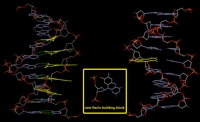
Department of Chemistry and Pharmacy, Ludwig-Maximilians-University, Butenandtst. 5-13 (building F), D-81377 Munich, Germany

 |
Martin von Meltzer and Thomas Carell
Department of Chemistry and Pharmacy, Ludwig-Maximilians-University, Butenandtst. 5-13 (building F), D-81377 Munich, Germany |  |
The electron injecting properties of a flavin in DNA has been used in a model system for excess electron transfer through DNA [1]. It has been shown that a single flavin, which has been incorporated into the same DNA-strand as a cyclobutane-pyrimidine dimer (CPD), is able to mimic the repair mechanism of DNA-photolyase [2] and cleaves the CPD after irradiation.
Up to now the flavin-DNA building block comprises an acyclic sugar backbone. The 2'- and 4'-positions are protected by a benzylidene group. This bulky group disturbs the DNA double strand: the perturbation prevents electron transfer in the 3'-5'-direction [3]. Many attempts to stabilise the flavin-building block in its furanosidic form have been unsuccessful to date. We have successfully synthesised a stable building block by replacing the sugar with its carbocyclic analogue.
Initial attempts to incorporate this carbocyclic analogue into DNA have been successful in moderate yields. This new tool will hopefully allow us to investigate electron transfer in an intact duplex.
Using this intact duplex it should now be possible to compare rates of repair by inserting one CPD at each side of the flavin and variation of the base sequence between the flavin as function of one CPD.
Furthermore incorporation of more than one flavin with a similar redox-potential to a metal into a DNA-strand can lead to "organic wires".